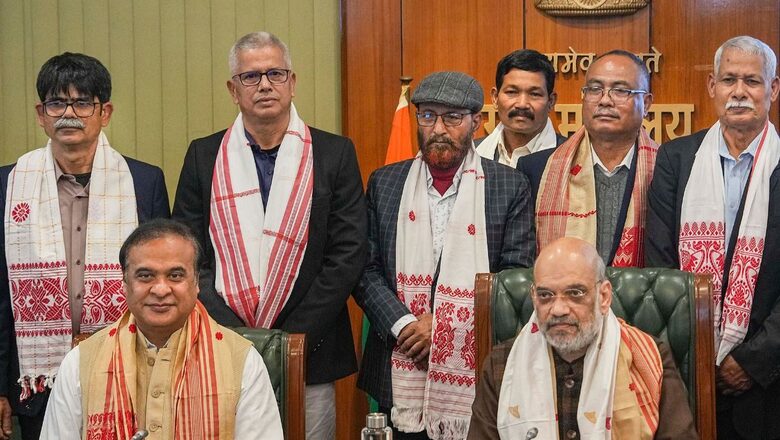
views
On December 29, the Government of India and the Assam government signed a peace pact with the pro-talks faction of the United Liberation Front of Asom (ULFA), which was once the most dreaded terrorist organisation of the state. The pro-talks faction is led by Arabinda Rajkhowa and includes leaders like Anup Chetia and Sashadhar Choudhury. As a result of the pact, 700 cadres of the group will join the mainstream. ULFA is the oldest insurgent group in the state.
An end to a chapter of insurgency in Assam
Although the ULFA has weakened, the signing of the pact is significant as this is the right step towards consolidating peace in the Northeast state, which has been affected by insurgency in the last four decades. The group has been in talks with the Centre since the time of the Manmohan Singh-led United Progressive Alliance. The initiatives of the then government found support in the state headed by Tarun Gogoi of the Congress.
In 2014, when the Narendra Modi government came to power at the Centre, the peace process got delayed. However lately, the dual efforts of both Assam Chief Minister Himanta Biswa Sarma and Union Home Minister Amit Shah to bring a conclusion paid off in sealing this peace deal — thus ending an important chapter of insurgency of the state to an end. This is the reason this pact is termed a historic pact for Assam as well as the region because it’s also likely to have a bearing on other ongoing peace talks, more particularly the Naga Peace Talks with the National Socialist Council of Nagaland (Isak-Muivah), ongoing for more than 26 years and still yet to reach a conclusion.
Insurgency hasn’t ended completely
Amid the euphoria of the peace pact with the pro-talks ULFA faction, it shouldn’t be forgotten that the smaller faction of the ULFA led by hardline leader Paresh Barua — known as ULFA (Independent) — has remained hostile to peace talks. Barua has stated that his faction will join the negotiation table only if the Centre agrees to discuss the sovereignty issue during the negotiations. Although this faction is smaller in strength with about 200 cadres and operating from the hideouts of Myanmar, it has been trying hard to get active.
In recent times, the faction has been able to attract new members. Last December, a journalist from Dibrugarh district working for a local daily confirmed his joining in ULFA(I) through social media. In the same month, the Assam police with the help of Assam Rifles nabbed three youths on their way to join ULFA(I). As 2024 starts its journey, there are reports about an IIT Guwahati employee joining the ULFA(I) — the first instance of joining the terrorist group after the signing of the peace pact with the pro-talks faction of the ULFA. This joining shows that it’s not only the jobless youth who are inclined to join the ULFA(I). These developments bring back the focus to the peace pact and its impact on the Assamese people.
Modi-led BJP shouldn’t repeat the mistakes of Congress-led governments
No doubt that the signing of the peace pact is a step towards the right direction in stabilising the peace of the Northeast state. However, the Central government should be cautious about the pact. It should avoid the mistakes made by the Congress governments of the Centre after signing the historic Assam Accord of 1985. The accord came into being after the state erupted in protests for six years to secure the interests of the indigenous people following the immigrants coming from neighbouring Bangladesh, earlier known as East Pakistan, and settling in the state.
However, Congress ignored the interests of the indigenous population. There are allegations that the Grand Old Party-led government facilitated Muslim immigrants to the state to consolidate its vote bank. These allegations are not out of reality — the passage of the Illegal Migrants (Determination by Tribunals) Act 1983, applicable to only Assam, by the Indira Gandhi-led Congress government strengthens these allegations. This act made it difficult to deport illegal immigrants from the state and in a sense, made the Assam Accord less effective. This controversial act was later challenged by then Assam Gana Parishad MP Sarbananda Sonowal, who later went on to become the first BJP chief minister of the state and is currently a Union minister in the Modi government. The controversial law was later struck down by the Supreme Court in 2005.
Fears of being reduced to a minority concern the Assamese
The Assamese-speaking population remained unsatisfied after the events that followed the Assam Accord and it was during this time, that the ULFA, formed in April 1979, started gaining popularity among the locals. However, later it turned into a terrorist organisation as it tortured the common people and even collaborated with Pakistan’s Inter-Services Intelligence (ISI), which wanted to use the former for terrorising the Assamese, and as a result, lost the support of the majority of the Assamese. In addition to this, the actions of the security forces finally weakened the organisation.
Although ULFA weakened, the fears of the Assamese, often dismissed by a large section of the mainstream media as exaggeration, are genuine. According to the Census of 2011, the population speaking Assamese was 48.38 per cent. This was a sharp decline in comparison to the 1971 Census, which put the Assamese-speaking population at 60.9 per cent. True that there was an increase of 15.27 per cent Assamese-speaking population in 2011 in comparison to the Census of 2001, but the fact can’t be denied that the Assamese-speaking population is now even less than 50 per cent in the state. The Assamese people fear that their population is likely to see a further dip and as a result, they are likely to lose political power as happened to the tribals of the neighbouring state of Tripura, where Bengali refugees coming from then East Pakistan became a majority.
Although the Opposition parties of the state are criticising the peace pact with the ULFA(I) as a poll-gimmick by the ruling BJP ahead of the Lok Sabha elections, the pact in reality hasn’t ignored the rights of the indigenous people. The most significant part of the peace pact is that it includes the continuation of the guidelines and methodology adopted for the delimitation process conducted in 2023 for future delimitations. Importantly, the delimitation process was conducted by taking the numbers of the 2001 Census and as a result of the process, there has been an increase of three seats for the Scheduled Tribes (ST) and one seat for the Scheduled Castes (SC).
According to Assam Chief Minister Himanta Biswa Sarma, the delimitation process has secured at least 96 seats for the indigenous people in the Assamese-dominated Brahmaputra Valley. He also stated that another eight seats have become secure for the indigenous people in the Bengali-dominated Barak Valley. According to reports, the delimitation exercise has reduced the Muslim-dominated seats from 35 to 25. It has to be mentioned that the majority of Muslims speak Bengali while a minority speak Assamese, who are seen as indigenous by the Assamese society.
The Centre has also promised to give ST status to six communities of the state — Tai-Ahoms, Koch Rajbonshis, Sooteas, Morans, Muttocks and Tea Tribes. This is also another key demand of the pro-talks faction of the ULFA. It has to be mentioned that giving ST status to these six communities was an election promise made by the BJP in the 2014 Lok Sabha elections and 2016 state assembly elections. If these communities are given ST status, over 50 per cent of Assam’s population will belong to ST and the state will then become officially a tribal state. This is the reason the pro-faction of the ULFA has been demanding this as it believes it will ensure political power remains with the indigenous people of the state. However, the saffron party is yet to fulfill its election promise fearing that this may upset the current ST communities of the state, who are currently known as vote-banks of the saffron party.
CAA and incomplete NRC keep the fear of Assamese alive
The Citizenship Amendment Act (CAA) of 2019, which is yet to be implemented, keeps alive the fears of the Assamese, who are also unsatisfied with the National Register of Citizens (NRC) data of 2019 for including many illegal immigrants. When the CAA was enacted, it was Assam which first witnessed protests against the act but their reasons for opposing were different from the Leftists and liberals. They argued that Assam had already accepted the persecuted Hindu Bengalis of East Pakistan till 24 March 1971 — the cut-off date for entry of immigrants into the state as settled through the Assam Accord. The CAA, however, further pushes the cut-off date to December 31, 2014. That’s the reason it was opposed by a large section of the Assamese.
However, Himanta Biswa Sarma had clarified then that there was nothing to fear because only five lakh Hindu Bengali immigrants, already living in Assam, would gain citizenship in the state. No doubt that the delimitation of 2023 has secured the rights of the indigenous people in at least 96 seats in the Assamese-dominated Brahmaputra Valley, but the BJP still faces the challenge of securing the faith of Assamese people with CAA and incomplete NRC posing as barriers.
The saffron party has to give confidence to the Assamese that even after implementing the CAA, their rights would remain secure, only then the fruits of the peace pact will be visible. Until and unless the fears of the Assamese remain, there will always be risks to the hard-achieved peace of the Northeastern state.
The author is a political commentator and tweets @SagarneelSinha. Views expressed in the above piece are personal and solely that of the author. They do not necessarily reflect News18’s views.




















Comments
0 comment